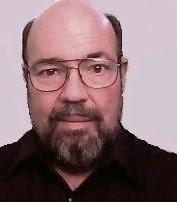I'll confess that the Dumont Network was just about gone by the time I arrived on the scene. It's heyday, if you could call it that, was the late 1940's and early 1950's. The network ended most of it's operations in the spring of 1955, and ceased operating entirely in 1956.
(Click to view 9 sec logo)
The Dumont Network was the world's first commercial broadcast network, although it would be quickly followed by NBC, CBS, and ABC (all established radio broadcasters) into the medium. It was owned by DuMont laboratories, a largely forgotten television equipment and set manufacturer.
While experimental television was around in the 1930's, the number of receivers numbered in the low thousands until the 1940s. Throughout the 1930's, the standards for broadcasting were constantly changing, and it wasn't until 1941 the FCC felt that the technology was mature enough to begin issuing commercial broadcast licenses.
According to Wikipedia:
The first licenses were issued to NBC and CBS owned stations in New York on July 1, 1941, followed by Philco's station in Philadelphia, then licensed as WPTZ and eventually licensed again as the present-day KYW-TV.
After the U.S. entry into World War II, the FCC reduced the required minimum air time for commercial television stations from 15 hours per week to 4 hours. Most TV stations suspended broadcasting.
During the early days of television local stations often offered programming fare from more than one network. Setting up broadcast stations in individual cities was very expensive, and so networks allowed their programming to be `shared'.
The Dumont Network's shows were, by necessity, very low budget affairs. Dumont was also disadvantaged because they didn't already have a radio network, and as stable of shows and established stars to draw from.
Again from the wikipedia, here is a list of some of their better known shows.
Cavalcade of Stars, a variety show hosted by Jackie Gleason, was the birthplace of The Honeymooners (Gleason left for CBS in 1952). Bishop Fulton J. Sheen's devotional program Life Is Worth Living went up against Milton Berle in many cities, and was the first show to successfully compete in the ratings against "Mr. Television". In 1952, Sheen won an Emmy for "Most Outstanding Personality".[13] The network's other notable programs include:
- Ted Mack's Original Amateur Hour, which began on radio in the 1930s under original host Major Bowes
- The Morey Amsterdam Show, a comedy/variety show hosted by Morey Amsterdam, which started on CBS before moving to DuMont in 1949
- Captain Video and His Video Rangers, a hugely popular kids' science fiction series[14][15]
- The Arthur Murray Party, a dance program
- With This Ring, a panel show on marriage
- Rocky King, Inside Detective, a private eye series starring Roscoe Karns
- The Plainclothesman, a camera's-eye-view detective series
- Live coverage of boxing and professional wrestling, the latter featuring matches staged by the Capitol Wrestling Corporation, the predecessor to World Wrestling Entertainment
- Cash and Carry, the first network-televised television game show
No one knew, in the early days, if this new medium called television would catch on. Radio entertainment was still king, and with the price of television receivers often approaching a year's salary for many people, many felt that TV was never going to amount to much.
Of course, the price of televisions came down as more were manufactured. Early on, televisions were more likely to be found in bars and restaurants than private homes, but that would quickly change by the early 1950's.
While it may seem inconceivable today, we had the ability to broadcast video and audio over the airwaves for decades before we learned to capture these shows on videotape.
Early TV shows survive today mostly due to Kinescope recordings, although the first video recorder was tested by Charles P. Ginsberg in 1951. By 1956, Ampex would offer the first commercial video tape record for a cool $50,000.
Kinescope recordings were made by placing a motion picture camera in from of a television monitor and recording the live broadcast as it was being aired. This allowed shows performed on the east or west coast to be shipped to the opposite coast, and broadcast, a week or so later.
Sadly, most of the Dumont Network's kinescopes, which were reportedly stored in a warehouse until the 1970s, were reportedly destroyed to save the costs of storage. A huge chunk of Americana went with it.
Today a relatively small number of shows still survive.
One of the shows that we still have a number of episodes from was Rocky King, Detective, which ran from 1950 to 1954. The UCLA Film and Television Archive supposedly has 37 episodes all tolled.
Staring Roscoe Karns, who's career began in 1915 in the silent movie Mr. Carlson of Arizona, but reached its peak in the 1930's when he parlayed his fast-talking wise-cracking delivery into a successful career as a character actor.
Todd Karns, Roscoe's son also appears. Todd Karns is probably best known for his role as Jimmy Stewart's kid brother, Harry Bailey, in It's A Wonderful Life, but appeared in many movies and television shows between 1941 and 1955.
These four episodes are hosted on the Internet Archive. If you can ignore the low budgets, and at-times dated dialog, I think you'll find these shows to be entertaining.
Flubbed lines, by the way, were common in the days of live television and personally I find they make these shows more endearing. Of course, your mileage may vary.
In the last of these four shows, Roscoe Karns was taken ill shortly before broadcast time. These shows were live, and something had to be done. A swift re-write enabled Roscoe's son to `handle the case' - relaying details to his boss Roscoe - who was at `home in bed' in the capable hands of Mabel, his wife.
![[movies]](http://www.archive.org/images/mediatype_movies.gif)
"Rocky King Detective" - Murder, PH.D.
Episode "Murder, PH.D." of the classic 50's TV series "Rocky King, Detective", which ran on the DuMont Television Network from 1950 to 1955.
![[movies]](http://www.archive.org/images/mediatype_movies.gif)
'Rocky King, Detective' - The Hermit's Cat (Classic TV) (1952)
"Rocky King, Detective" aired on the short-lived DuMont Television Network from 1950 to 1954.
![[movies]](http://www.archive.org/images/mediatype_movies.gif)
"Rocky King, Detective" - Murder Scores a Knockout (Classic TV)
1952 Episode "Murder Scores a Knockout" of the low-budget DuMont Television Network series "Rocky King, Detective".
![[movies]](http://www.archive.org/images/mediatype_movies.gif)
'Rocky King, Detective' - One Minute for Murder
Episode "One Minute for Murder" of the "Live" 50's TV series 'Rocky King, Detective'. As the lead actor was sick, Roscoe Karn's son does lead instead.

![[item image] [item image]](http://ia360618.us.archive.org/2/items/DuMont_Network/DuMont.gif)






No comments:
Post a Comment